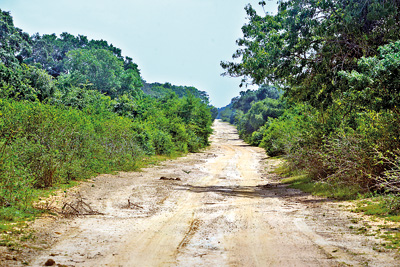News
‘Stop roads through NPs to mitigate climate change’
Sri Lanka is caught in the stranglehold of a dry spell, with major water scarcities, power shortages and crop failures.

The road through the Wilpattu National Park
As men, women and children are warned against heat-strokes and told to drink lots of water, the blame falls squarely on climate change.
“Climate change is the defining issue of our time and we are at a defining moment. From shifting weather patterns that threaten food production, to rising sea levels that increase the risk of catastrophic flooding, the impacts of climate change are global in scope and unprecedented in scale. Without drastic action today, adapting to these impacts in the future will be more difficult and costly,” the United Nations has warned.
This is while climate scientists believe that “human activities” are very likely the main cause of global warming since the mid-20th century, including the use of fossil fuels (burning coal, oil and gas which produce carbon dioxide, an important greenhouse gas in the atmosphere) and deforestation.
It is deforestation that many environmentalists focus on to stress the point that simple measures within Sri Lanka such as not intruding into precious Protected Areas (PAs) of the country would help mitigate climate change to some extent.
“The exploitation of forests plays a major role in climate change, as trees help regulate the climate by absorbing carbon dioxide from the atmosphere. When trees are axed or bulldozed, this positive effect which is crucial for our very existence is lost,” says environmental lawyer, Jagath Gunawardena, citing simple but critical examples of the destruction of PAs such as National Parks by constructing roads through them.
Even though climate change is such a serious issue, the destruction of forests goes unabated, said Mr. Gunawardena, turning the spotlight on roads within National Parks which are built with impunity and in clear contravention of the Fauna and Flora Protection Ordinance (FFPO).
The impacts, of course, are traffic, noise, fumes and human activity, while the more insidious adverse impact is the ‘edge effect’, according to him.
Explaining what the ‘edge effect’ is, Mr. Gunawardena says that the disturbance caused by the building of a road gradually degrades the surroundings, not just the area where the road is, followed by the destruction of that habitat.

Lawyer Jagath Gunawardena

Dr Sevvandi Jayakody
On journeys to the Wilpattu National Park, he has noted with concern invasive plants establishing themselves along the roadside and gradually spreading into the surroundings and interfering with the habitat and biodiversity.
“What happens ultimately is that invasive plants ‘get a hold’ of the environment, causing a reduction of other species,” says this activist, citing the ‘classic’ example of guinea grass, a major invasive he has seen at the Wilpattu National Park.
He also points out that it is not only within a National Park that such things happen but also just outside National Parks where the FFPO is obviously ignored for monetary gain.
The argument of many is that some development projects such as plantations of this or that type are not within the boundaries of a National Park but the question that arises is whether the mandatory Environmental Impact Assessment (EIA) has been carried out, if such plantations are within one mile from the boundary.
The FFPO is clear as crystal. Under Section 9A of the FFPO, any development activity within 1 mile from the boundary of a National Park may be carried out only after an EIA which should be open for comment by the public for 30 days and the Fauna and Flora Advisory Committee for 60 days. Thereafter, the project can be approved with strict conditions or rejected by the Department of Wildlife Conservation (DWC).
“Many are the issues that are caused by roads running through PAs,” underscores the Director of the Environmental Foundation Ltd. (EFL), Dr. Sevvandi Jayakody, echoing the concerns expressed by Mr. Gunawardena.
Specific instances are highlighted – in Ampara where the Moragahakanda project caused inroads into several National Parks and the road running through the Wilpattu National Park.
“Sometimes, some of the roads have been approved if there is a national need, but it must be ensured that such roads are constructed following the conditions laid down by the DWC,” she says, adding that the problem is that once these roads are built within PAs, there follows pressure to use them like any other road outside the PAs.
She is adamant that “this cannot or should not be allowed” and the conditions which have been laid down – such as closure of road during the night to allow animals the freedom to cross the road without fragmenting the PA or prevent road kills – have to be adhered to strictly. The ‘hospitality’ extended by the DWC, giving some leeway taking into account national development needs, should not be abused or misused.
To ensure this, development agencies should work with the relevant regulatory body whether it is the DWC, the Forest Department, the Coast Conservation Department (CCD), the Irrigation Department or any other, says Dr. Jayakody.
Looking closely at mega development projects of the private sector, she concedes that now the mandatory Initial Environment Examination (IEE) or EIA is performed. But when many government institutions undertake development projects, there is a tendency to ignore this mandatory requirement.
The trade-off for having an intrusion into the National Park is carrying out a proper EIA and introducing mitigatory measures and implementing those measures, she says.
Another critical issue that Dr. Jayakody focuses on is that there is no post-monitoring mechanism for evaluation. Once development starts and something goes wrong, there is no mechanism for monitoring to ensure all the conditions specified are met. In many instances, such conditions are limited to the written document.
Therefore, there should be a plan setting out such a monitoring mechanism and also how the development agency should allocate resources and finances to meet this need, she added.

